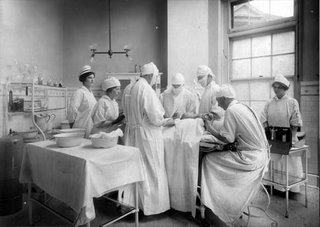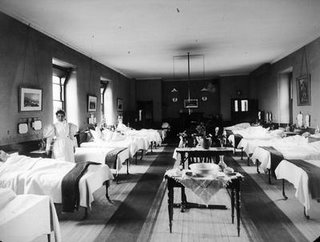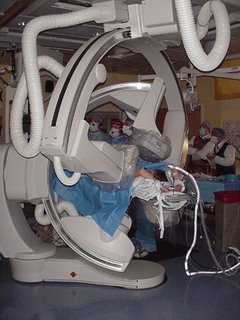It's 1920. The hospital in your city is a facility run by nuns or the church. It's a place for the very ill, often without hope of meaningful treatment, but nonetheless a place where surgeries take place, babies are born, the injured and chronically ill can find care. No one has health insurance and there's no Medicare. Everyone pays what they can. The hospital is accustomed to doling out plenty of care without compensation. For that reason, they welcome donations and sometimes will build new additions or other facilities in honor of a major donor.
Volunteeers are common, since the wards are understaffed and generally suffering from a shortage of trained nurses and personnel associated with the church. Drugs, such as they are, are often prepared from basic ingredients in the hospital pharmacy. Product representatives hawking medicines and devices are virtually unheard of.
Though their therapeutic tools are limited, the physicians are a proud group, dedicating their careers to healing. The majority of the medical staff volunteer large portions of their time to care for the poor who come to the hospital with very advanced stages of disease: metastatic tumors, advanced heart failure, debilitating strokes, overwhelming septicemia, etc.
Hospitals are usually governed by a board of clergy and physicians who make decisions on how to apply their limited resources and continually seek charitable donations.
Fast forward to present day: Hospitals are high-tech, professional facilities with lots of skilled people, complicated equipment,and capable of complex procedures. While they still house people with advanced illnesses, the floors are also filled with people with much earlier phases of disease. In general, they do a good job, with quality issues scrutinized by a number of official agencies to police practices, incidence of hospital-related infections, medication errors, care protocols, etc.
The hospital of 2006 is a more more effective place than the hospital of 1920. But its aims and operations are different, also. Though some churches are still involved in hospitals, more and more are owned by publicly-traded companies that answer to shareholders--shareholders who want share value to increase. Though donations are still sought, much of the revenues are obtained by concentrating on profitable, large-ticket procedures. More procedures are often generated by advertising.
Because they operate to generate profits, several hospitals in a single city or region compete with one another. The 21st century has therefore witnessed the phenomenon of hospital-owned physicians: more and more practicing physicians are employees of their hospital. That way, the physician brings all his patients and procedures to his hospital, not to a competitor. The top of the funnel is the primary care physician, who tends to see all disease when it first occurs. The primary care physician then sends the patient to the specialist, who is obliged (by contract) to perform his/her procedure in the hsopital paying their salary.

Representatives from companies manufacturing and selling expensive hospital equipment and drugs are everywhere, falling over themselves to gain attention of the physicians using their equipment and the hospital buyers who make purchasing decisions. Millions of dollars can be transacted with just one sale.
The number of volunteers has dwindled. The poor and uninsured are commonly diverted elsewhere, often to a government-funded, and often second-rate, institution. Hospitals measure success by comparing annual revenues and numbers of major procedures.
The hospital of 2006 is a vastly different place than 1920. If you're expecting charitable treatment, compassion, and selfless care, you're in the wrong century. In 2006, the hospital is a business. You don't expect charitable treatment at Wal-Mart or from your car dealer. Don't expect it from your hospital. They are businesses and you are a customer. Recognize this fact, lose the nostalgia for the hospitals of yesterday, and a lot more will become clear to you.